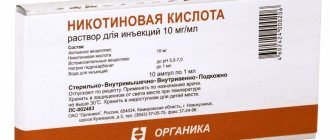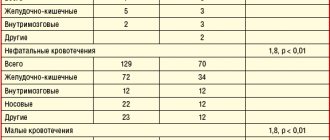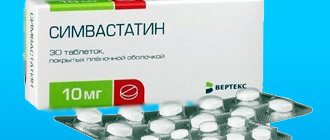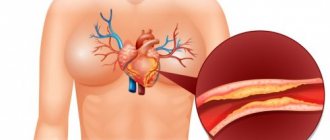IHD - coronary heart disease
MI - myocardial infarction
HDL - high density lipoprotein
LDL - low density lipoproteins
NA - nicotinic acid
NK-MVDV - nicotinic acid with slow release of the active substance
NK-NVDV - nicotinic acid with immediate release of the active substance
ACS - acute coronary syndrome
DM - diabetes mellitus
CVD - cardiovascular disease
TG - triglycerides
CS - cholesterol
Prerequisites for the study
Coronary heart disease (CHD) is diagnosed in more than 18 million North Americans. Despite significant progress in both drug therapy and invasive interventions, the incidence of complications and mortality in this disease remain quite high [1, 2]. Elevated concentrations of low-density lipoprotein (LDL) cholesterol (LC) are among the known risk factors for the development of coronary artery disease. In the course of many studies assessing the effectiveness of statins for the purpose of primary and secondary prevention of complications of cardiovascular diseases (CVD), a statistically significant reduction in the risk of developing such complications by 25-35% was revealed [3], but despite achieving the desired level of LDL cholesterol , there was a residual risk of developing such complications.
The results of epidemiological studies have shown that, in addition to an increased concentration of LDL cholesterol, a low level of high-density lipoprotein cholesterol (HDL) in the blood becomes an independent prognostic factor for the risk of developing coronary artery disease [4, 5]; Moreover, there is a strong inverse relationship between the concentration of HDL cholesterol and the incidence of complications of coronary artery disease. Previous studies included in the Coronary Drug Project found that the incidence of CVD complications was reduced in patients with confirmed coronary artery disease who were randomized to the immediate-release nicotinic acid (NINA) group compared with patients who were assigned to the placebo group [6, 7]. At the same time, the results of the VA-HIT (Veterans Affairs HDL Intervention Trial) study [8] suggested that an increase in HDL cholesterol concentrations when using gemfibrozil in men with coronary artery disease and normal LDL cholesterol levels is accompanied by a decrease in the incidence of CVD complications. Later, during the HATS (HDL-Atherosclerosis Treatment Study) study [9], data were obtained that indicated that the combined use of simvastatin and nicotinic acid (NA) led to a statistically significant reverse development of atherosclerosis of the coronary arteries according to angiography, as well as to reduce the incidence of adverse clinical outcomes.
At least 2 RCTs [10, 11] have evaluated the effectiveness of intensive lipid-lowering regimens using high-dose statins to achieve the desired LDL-C level in the blood of less than 1.81 mmol/L in patients with a very high risk of developing CVD complications. The results obtained indicated a significant reduction in the incidence of adverse clinical outcomes. According to a secondary analysis of the TNT (Treating to New Targets) study [11], in the subgroup of patients with an LDL cholesterol level of less than 1.81 mmol/l, whose HDL cholesterol concentration was in the upper quartile, the incidence of CVD complications over 5 years was 25% lower than in the subgroup of patients with the same LDL cholesterol level, but HDL cholesterol levels in the lower quartile range. These data suggest that HDL-C concentrations have prognostic value in patients taking statins, regardless of LDL-C levels. Patients with such levels of lipids in the blood constitute a fairly large group at increased risk of developing CVD complications [12, 13], which requires the use of effective therapy.
Purpose of the study
To test the hypothesis that the use of NK-MVDV in addition to an intensive regimen of statin therapy compared with its isolated use in patients with an established diagnosis of atherosclerotic CVD and atherogenic dyslipidemia (low concentration of HDL cholesterol, elevated levels of triglycerides (TG), as well as the presence of small dense particles of LDL cholesterol) will lead to a decrease in the incidence of CVD complications.
Research structure
Multicenter, randomized, double-blind, placebo-controlled study performed in the USA and Canada; mean follow-up duration was 36 months.
Sick
The study included patients aged 45 years and older with CVD, which was diagnosed in the presence of confirmed coronary artery disease, cerebrovascular disease, and carotid or peripheral artery disease. To be included in the study, patients had to have low HDL cholesterol levels (less than 1.03 and 1.30 mmol/L for men and women, respectively) and elevated TG concentrations (range from 1.69 to 4.52 mmol/L ), and the LDL cholesterol level is less than 4.65 mmol/l, if patients were not taking statins when included in the study. After a preliminary examination, patients were required to stop taking medications that affect blood lipid levels, with the exception of statins and ezetimibe, at least 4 weeks before inclusion in the study. At baseline, fasting blood lipid levels were determined, followed by analysis in a central laboratory. Patients were not included in the study if they were hospitalized for acute coronary syndrome (ACS) within 4 weeks before inclusion, or had undergone a planned revascularization procedure, or if they had suffered a stroke within the previous 8 weeks. The baseline characteristics of the patients are presented in detail in the table.
Intervention
In the NC application group (NC group), patients took NC 1500-2000 mg/day in combination with simvastatin, in the placebo group - simvastatin in combination with placebo, which contained small doses of NC-NVDV (50 mg) in each tablet that simulated use NC 500 or 1000 mg in order to ensure the double-blind principle during the study. In both groups, the dose of simvastatin was selected in accordance with the algorithm contained in the protocol, with the goal of achieving and maintaining LDL cholesterol concentrations from 1.03 to 2.07 mmol/l during the study. In addition, in both groups, in order to achieve the desired level of LDL cholesterol in the blood, ezetimibe was allowed to be taken at a dose of 10 mg/day. To comply with the double-blind principle, only the results of the analysis of LDL cholesterol concentration in the blood were reported to the study centers. Compliance with NC or placebo was assessed using a pill count at each study site visit.
Evaluation criteria/Clinical outcomes
Primary: composite rate of the first adverse clinical outcome of death from complications of coronary artery disease, nonfatal myocardial infarction (MI), ischemic stroke, hospitalization for ACS (with a hospital stay of more than 23 hours), and myocardial revascularization or brain, which was due to clinical manifestations. Additional: a combined indicator of mortality from coronary artery disease, the incidence of non-fatal myocardial infarction, ischemic stroke, or hospitalization for ACS with a high risk of developing an unfavorable outcome (this risk was determined when clinical manifestations of ischemia intensified or in the presence of prolonged attacks of chest pain, which were accompanied by signs of ischemia at electrocardiogram or an increase in the concentration of biomarkers of myocardial damage above the upper limit of normal, but less than 2 times compared to it); a combined indicator of mortality from complications of coronary artery disease and the incidence of non-fatal myocardial infarction or ischemic stroke; mortality from CVD complications. In addition, indicators such as overall mortality, individual components of the main indicator, as well as the incidence of adverse outcomes in subgroups formed depending on gender, the presence or absence of diabetes mellitus (DM) in history, and the presence or absence of metabolic syndrome were assessed.
Statistical analysis methods
At baseline, the primary composite indicator included adverse clinical outcomes such as death from complications of coronary artery disease, nonfatal myocardial infarction, ischemic stroke, and high-risk ACS. Because the rate of adverse outcomes included in the primary outcome was lower than expected during the study, protocol amendments were adopted to replace the rate of high-risk ACS with the rate of hospitalization for ACS and myocardial and cerebral revascularization using arterial intervention , the disturbance of blood flow in which caused the development of clinical symptoms. This analysis of the incidence of adverse outcomes was performed by members of the study executive committee, while maintaining blinding. Members of the independent data review committee appointed by the US National Heart, Lung, and Blood Institute were blinded to the results of a particular treatment strategy and, after completing their review, recommended adoption of an appropriate protocol amendment in March 2010. It was hoped that during the course of this study, which was intended to be carried out until a certain number of adverse clinical outcomes included in the main indicator were achieved, with 800 such confirmed outcomes to develop within 4.6 years. Based on the calculated number of outcomes, the statistical power of the study to detect reduction in the revised 5-component core measure was determined to be 85% at a one-sided alpha level of 0.025. It was assumed that a formal interim analysis would be performed with certain asymmetric boundaries, the results of which should be the basis for early termination of the study both in the event of treatment effect and in case of its ineffectiveness. To meet the margin of ineffectiveness, a hazard ratio of 1.02 or greater was required for a p value for treatment futility of less than 0.001 if 50% of the predicted number of adverse outcomes were reported. The study was expected to continue until December 2012. At a meeting held on April 25, 2011, members of the data and safety monitoring committee recommended discontinuation of the blinded intervention because the margin for ineffectiveness had been crossed and was not intended. previously high incidence of ischemic stroke in patients taking NC; Such recommendations have been adopted by the US Heart, Lung, and Blood Institute.
Baseline characteristics of patients, adherence data, and differences in percentage changes in blood lipid concentrations were compared between groups using the c2 test or two-sample t test. The statistical significance of changes in blood lipid concentrations in the NC group was assessed using the Wilcoxon test. Data presented as ordinal numbers, such as statin dose, were compared using Spearman's rank correlation test. All types of analysis of the main indicator were carried out on the assumption that all patients received the prescribed treatment. Analysis of efficacy indicators was performed using methods that took into account the time of development of an adverse clinical outcome. The unstandardized log-rank test was used to compare treatment outcomes between groups, the Cox proportional hazards model was used to calculate hazard ratios and confidence intervals, and the standardized Wald test was used to analyze various outcomes. Models were standardized according to the presence of diabetes and gender. The results of the analysis in subgroups of patients with predefined characteristics were presented without taking into account multiple comparisons. Testing for the statistical significance of the interaction between the effect of treatment on the main outcome and certain characteristics of patients included in certain subgroups was performed using the Cox model.
results
Of the 8162 patients who signed informed consent, 4273 (52.4%) began openly taking NC during the run-in period; of these, 3414 (79.9%) were randomly assigned to the NC group (n=1718) or placebo group (n=1696). The average age of the patients reached 64±9 years; in total there were 85.2% men; 92.2% of patients belonged to the Caucasian race. Diabetes (type 1 or 2), arterial hypertension and metabolic syndrome were observed in 33.9, 71.4 and 81.0% of patients, respectively. The patient groups did not differ significantly in all baseline characteristics (see table).
Of the 3196 (93.6%) patients who were taking statins at inclusion in the study, the median baseline concentrations of LDL cholesterol, HDL cholesterol and TG reached 1.84, 0.91 and 1.82 mmol/l, respectively. Before inclusion in the study, 76.2% and 39.5% of patients, respectively, had been taking statins for at least 1 year and for 5 years or more. Of the 218 patients who were not taking statins at inclusion in the study, the median baseline concentrations of LDL cholesterol, HDL cholesterol and TG reached 3.21, 0.85 and 2.43 mmol/l, respectively.
After 2 years, in the NC group, the concentration of HDL cholesterol increased by 25.0% to 1.09 mmol/l, and in the placebo group - by 9.8% to 0.98 mmol/l (p<0.001 for comparison between groups). TG levels in the NC group and the placebo group decreased by 28.6 and 8.1%, respectively. LDL cholesterol concentrations decreased further in the NC group and the placebo group by 12.0 and 5.5%, respectively. These changes in blood lipid levels persisted during 3 years of follow-up.
The development of adverse clinical outcomes included in the main outcome could not be assessed in 52 patients. During the study, the dose of the study drug in the NC group and the placebo group was reduced in 6.3 and 3.4% of patients, respectively. (p<0.001), and 25.4 and 20.1% of patients, respectively, completely stopped taking the study drug. (p<0.001). The annual discontinuation rate of NK-MVDV was as high as 8.4% of person-years, but overall adherence to continued use was at least 75%. More than 86% of patients continued taking simvastatin, and in almost 50% of them the dose of simvastatin reached 40 mg/day. In the placebo group compared to the NC group, statistically significantly more patients took simvastatin 80 mg/day, i.e. the maximum dose of this statin[] (24.7 and 17.5% of patients, respectively; p=0.02), and more patients took ezetimibe (21.5 and 9.5% of patients, respectively; p<0.001). Rates of use of medications that reduce the risk of heart disease complications (eg, aspirin, other antiplatelet agents, β-blockers, and renin-angiotensin system inhibitors) were high and similar in both groups during the study.
Adverse clinical outcomes included in the main composite indicator of mortality from complications of coronary artery disease, as well as the incidence of non-fatal myocardial infarction, ischemic stroke, hospitalization for ACS (in case of hospital stay for more than 23 hours), and myocardial or cerebral revascularization, which was due to clinical manifestations, in the NC group and the placebo group developed in 16.4 and 16.2% of patients, respectively. (hazard ratio 1.02, 95% CI 0.87 to 1.21; p=0.80 for proportional hazards analysis of benefit of NK-MVDV compared with placebo, and p=0 .79 for analyzes performed using the log-rank test). The results of the analysis of individual components of the main indicator indicated a previously not expected increase in the risk of ischemic stroke as the first adverse clinical outcome in the NC group compared to the placebo group: such an outcome developed in 1.6 and 0.9% of patients, respectively. It should be noted that in 8 patients included in the NC group, ischemic stroke developed between 2 months and 4 years after complete discontinuation of the study drug. The results of the analysis, which included data on all patients who developed stroke during the course of the study, and not just those in whom stroke was the first adverse clinical outcome, also indicated a trend towards an increased risk of ischemic stroke with the use of NC-MVDV compared with placebo (hazard ratio 1.61, 95% CI 0.89 to 2.90; p=0.11).
It should also be noted that during a repeated exploratory analysis of all possible neurological complications, which was performed by members of the clinical outcomes assessment committee in the absence of information about the results of the distribution of patients into groups using a certain treatment tactic, 3 cases of transient cerebrovascular accident were reclassified as ischemic stroke , but the results of this retrospective analysis were not included in the main analysis. The use of NK-MVDV compared with placebo also did not affect the additional composite indicator of mortality from coronary artery disease, the incidence of non-fatal myocardial infarction, ischemic stroke, or hospitalization for ACS with a high risk of adverse outcome (hazard ratio 1.08, 95% CI 0. 87 to 1.34; p=0.49) and on the additional combined indicator of mortality from complications of coronary artery disease, as well as the incidence of non-fatal myocardial infarction or ischemic stroke (risk ratio 1.13 with 95% CI from 0.90 to 1.42; p=0.30). The number of patients who died from CVD complications was small in both the NC group and the placebo group: 2.6 and 2.2% of patients died from such causes, respectively. (p=0.47).
There was no statistically significant interaction between the effect of treatment on the main indicator and certain characteristics of patients included in individual subgroups, in particular such characteristics as age (younger than 65 years or 65 years and older), gender, presence or absence of diabetes, metabolic syndrome, previous history of myocardial infarction and the use of statins upon inclusion in the study.
Side effects were rare and included pathological changes in biochemical parameters of liver function (in the placebo group and NC group in 0.5 and 0.8% of patients, respectively), symptoms of muscle damage or myopathy (overall in 0.3% of patients), and rhabdomyolysis (in the placebo group and the NC group in 1 and 4 patients, respectively).
conclusions
In patients with atherosclerotic CVD and LDL cholesterol concentration less than 1.81 mmol/l, the addition of NC to statin therapy over 36 months of observation does not lead to additional benefits, despite a statistically significant increase in HDL cholesterol levels and a decrease in TG concentrations in the blood.
A comment
The results of the AMI-HIGH study indicate that in patients with non-acute CVD and low baseline LDL-C levels who achieved and maintained an LDL-C concentration of less than 1.81 mmol/L while using an intensive statin therapy regimen, combined use NK-MVDV in combination with simvastatin compared with simvastatin alone is accompanied by a statistically significant increase in the concentration of HDL cholesterol and a decrease in the level of TG in the blood. However, this does not lead to a statistically significant reduction in the main composite indicator of the incidence of CVD complications during an average follow-up of 36 months. It should be noted that 94% of patients were taking statins at the time of inclusion in the study, and many of them were taking drugs belonging to this class for a long time. In addition, 20% of patients had previously used NC. After 2 years of observation in the NC group, there was an additional decrease in LDL cholesterol concentration by 12% (median achieved LDL cholesterol concentration 1.55 mmol/l) and an increase in HDL cholesterol concentration by 25% (median achieved HDL cholesterol concentration 1.09 mmol/l) , while in the placebo group there was only a minimal decrease in the concentration of LDL cholesterol (median achieved concentration of LDL cholesterol 1.76 mmol/l), and the concentration of HDL cholesterol increased by 9.8% (median achieved concentration of HDL cholesterol 0.98 mmol/l). l).
In contrast to the results of previously performed clinical trials of NC [6, 14-16], which indicated clear advantages of taking NC as assessed using indirect indicators (the thickness of the intima-media complex of the carotid arteries [17] and the degree of reduction in stenosis of the coronary arteries according to angiography data [14]), and the incidence of adverse clinical outcomes, the data obtained during the AIM-HIGH study did not confirm the hypothesis of the clinical benefits of using NK-MVDV in patients with a confirmed diagnosis of coronary artery disease and a low initial level of LDL cholesterol in the blood.
It should be recalled that, according to the first placebo-controlled trial of NC Coronary Drug Project [6], the use of a high dose of NC-NVDV (3000 mg/day) leads to a statistically significant 14% reduction in mortality from complications of coronary artery disease and the incidence of myocardial infarction, as well as to a 26% reduction in the incidence of stroke or transient cerebrovascular accident, i.e. is accompanied by a reduction in the risk of adverse clinical outcomes that is similar to that observed in placebo-controlled clinical trials of statins. Data obtained during the Veterans Affairs HDL Intervention Trial [8], which included sick men (n=2531) with low baseline HDL cholesterol levels in the blood, indicated that the use of gemfibrozil leads to a 22% reduction in the main indicator (mortality). from complications of coronary heart disease and the incidence of non-fatal myocardial infarction) and to a 27% reduction in the incidence of stroke, despite the fact that the concentration of HDL cholesterol increased by only 6% (from 0.83 to 0.88 mmol/l). However, baseline LDL cholesterol in this study, which was performed before the widespread use of statins, was 2.87 mmol/L compared with 1.84 mmol/L in patients enrolled in the AIM-HIGH trial who were taking statins at enrollment. into the study. Baseline LDL cholesterol concentrations varied by 1.04 mmol/L between these studies. It is known that such a decrease in the concentration of LDL cholesterol causes a significant reduction in the incidence of CVD complications. In addition to the important role of statins in secondary CVD prevention, data from the AIM-HIGH trial further highlight the dramatic and ongoing improvements in drug therapy over recent decades. These improvements include the development and implementation of other disease-modifying interventions, including the use of antiplatelet agents, β-blockers (in post-MI patients), and angiotensin-converting enzyme inhibitors, all of which have been associated with improved prognosis. Such drugs were widely used in patients included in the AIM-HIGH study. It should be noted that the combined use of modern drug therapy, especially if such therapy included an intensive regimen of statins, which in both groups was accompanied by a decrease in LDL cholesterol concentration to approximately 1.55 mmol/l, could further reduce the incidence of CVD complications during performing the research. Overall, this may make it difficult to detect an additional clinical benefit associated with the use of another drug that affects blood lipids, such as NAs, fibrates, or cholesteryl ester transport protein inhibitors. Nevertheless, clinical studies are ongoing to evaluate the effectiveness of such drugs in patients with stable CVD: in particular, NC, during the HPS2-THRIVE study (Heart Protection Study 2: Treatment of HDL to Reduce the Incidence of Vascular Events) and protein inhibitors - cholesteryl ester transporter during the dal-OUTCOMES study (A Study of the Effect of Dalcetrapib on Atherosclerotic Disease in Patients with Coronary Artery Disease) and the REVEAL study (Randomized Evaluation of the Effects of Anacetrapib through Lipid Modification). Thus, the inclusion of patients in the large international study HPS2-THRIVE to comparatively evaluate the effectiveness of the use of NC in combination with laropiprant and the isolated use of simvastatin in patients with coronary artery disease has been completed. Unlike the AIM-HIGH study, the HPS2-THRIVE study did not pre-select patients based on specific blood lipid levels, such as low HDL cholesterol.
The previously unsuspected high incidence of ischemic stroke in the NC group also needs to be discussed. Although the total number of ischemic strokes was higher in the NC group, the overall incidence was low, so it is not possible to definitively answer the question of whether the increase in the incidence of such strokes was associated with the use of NC or was due to chance. It should be noted that the results of previous studies or meta-analyses did not indicate an increase in the incidence of stroke when using NC in any therapeutic form, dose and mode of administration. Although a careful analysis of cases of stroke and possible predisposing factors did not reveal a causal relationship between taking NK-MVDV and the development of ischemic stroke, the results obtained should be carefully studied in the course of further data analyzes, the AIM-HIGH study, as well as other RCTs of NC, which included patients with CVD.
Several limitations of this study should be noted. First, the results obtained cannot be generalized to all patients with coronary artery disease or to all patients with low LDL cholesterol concentrations. Although the results of the AIM-HIGH trial may cast doubt on the clinical effectiveness of therapeutic interventions aimed at increasing low HDL-C concentrations and reducing elevated blood TG levels (at least through the use of NC in patients with CVD and dyslipidemia who are in stable condition), it remains unclear whether such an intervention would be useful in other patient populations. The study excluded patients who had recently been hospitalized for acute coronary syndrome or acute myocardial infarction, who are at higher risk of developing CVD complications than those enrolled in the AIM-HIGH study. Only 6% of patients were not taking statins when entering the study, and their baseline LDL-C concentrations were much higher and their baseline HDL-C levels were lower than those of patients taking statins. Thus, it remains unclear whether the risk of developing CVD events in the 94% of patients who were taking statins at study entry and had very low baseline LDL-C concentrations was less than expected. In addition, it is unknown whether the use of an intensive statin regimen for 1 year or more resulted in the delipidation of the lipid-rich necrotic core and the transition of atherosclerotic plaques from an unstable state, which is accompanied by a high risk of rupture, to a stable state. The possibility of such stabilization of atherosclerotic plaques was recently confirmed in a clinical study [18]. In addition, the dissemination of the findings is also limited by the small number of women included in the study (15%) and the very small number of patients belonging to ethnic minorities (8%).
Second, patients in the placebo group received a small dose of NC-NVDV (50 mg) to ensure double-blindness. However, it seems unlikely that the modest increase in HDL-C concentrations observed in the placebo group could have been due to the very small dose of NK-MVDV contained in each placebo tablet, which simulated the administration of 500 or 1000 mg of NK-MVDV (thus, the total the dose of NK-NVDV taken by patients in the placebo group ranged from 100 to 200 mg/day). It should be noted that the results of studies in which participants took NK-NVDV at 100, 200 and even 500 mg once a day for 5 weeks indicated the absence of any changes in blood lipid concentrations that would persist for more than 4 hours after using a single daily dose of the drug [19]. In order to detect changes in the concentration of lipids or lipoproteins in the blood due to the use of NK-NVDV, it must be used several times a day.
Finally, it cannot be ruled out that the length of follow-up of patients during the study (an average of 36 months) may have been insufficient to detect clinical effects associated with NC intake. It should be noted, however, that the Kaplan-Meier curves for the primary outcome were essentially identical at the end of the study.
Thus, the AIM-HIGH study did not confirm the hypothesis that in patients with chronic atherosclerotic CVD and LDL cholesterol concentration less than 1.81 mmol/l, the addition of NC to statin therapy compared with taking a statin (both in combination with ezetimibe, and in its absence) during 36 months of observation leads to additional benefits, despite a statistically significant increase in HDL cholesterol levels and a decrease in TG concentrations in the blood. To test the hypothesis about the effectiveness of the use of NC in patients with a higher risk of developing CVD complications than the participants in the AIM-HIGH study or with a less pronounced decrease in the concentration of LDL cholesterol in the blood, new prospective clinical trials are necessary in the future.
[] Currently, experts from the US Food and Drug Administration consider the use of such a dose of simvastatin to be unjustified, since during the SEARCH (Study of the Effectiveness of Additional Reductions in Cholesterol and Homocysteine) RCT, the incidence of side effects when using simvastatin at a dose of 80 mg/day compared with taking simvastatin at a dose of 20 mg/day was accompanied by a statistically significant increase in the incidence of side effects. (Editor's note)
pharmachologic effect
Nicotinic acid is a specific antipellagric agent.
It has a pronounced short-term vasodilator effect, improves carbohydrate and nitrogen metabolism, has hypolipidemic activity, reduces the content of total cholesterol, low-density lipoproteins, triglycerides, increases the content of high-density lipoproteins, and improves microcirculation.
In the body, nicotinic acid is converted into nicotinamide, which binds to coenzymes codehydrase I and codehydrase II (NAD and NADP), which transport hydrogen, and participates in the metabolism of fats, proteins, amino acids, purines, tissue respiration, glycogenolysis, and synthetic processes.
Replenishes the deficiency of vitamin PP (vitamin B3), being a specific antipellagritic agent.
It has a vasodilating effect at the level of small vessels (including the brain), improves microcirculation, and has a weak anticoagulant effect (increases the fibrinolytic activity of the blood).
Pharmacokinetics
When administered parenterally, it is quickly distributed in the tissues of the body. It accumulates mainly in the liver, as well as in adipose tissue and the kidneys.
In the liver, nicotinic acid is converted into an amine, which is incorporated into nicotinamide adenine dinucleotide (NAD), which is a prosthetic group of enzymes. carrying hydrogen and carrying out redox processes.
The main metabolites are N-methyl-2-pyridone-3-carboxamide and N-methyl-2-pyridone-5-carboxamide, which do not have pharmacological activity.
It can be synthesized in the intestine by bacterial flora from tryptophan supplied with food (from 60 mg of tryptophan 1 mg of nicotinic acid is formed) with the participation of pyridoxine (vitamin B6) and riboflavin (vitamin B2). The half-life is 45 minutes.
It is excreted from the body by the kidneys in unchanged form and in the form of metabolites. Renal clearance depends on the level of nicotinic acid in the blood plasma and may decrease at high plasma concentrations.
Indications for use
— hypovitaminosis RR, vitamin deficiency RR (pellagra);
- spasms of blood vessels in the extremities;
— as part of combination therapy for ischemic stroke;
- obliterating diseases of the vessels of the extremities (obliterating endarteritis, Raynaud's disease);
- neuritis of the facial nerve;
— diabetes mellitus, including its complications (diabetic polyneuropathy, microangiopathy);
— Hartnup's disease (a hereditary disease accompanied by impaired absorption of certain amino acids, including tryptophan).
Side effect
After intravenous administration, rare: allergic reactions (skin rash, itching, wheezing, urticaria).
Paresthesia, dizziness, feeling of a “rush” of blood to the scalp, flushing of the skin of the face and upper half of the body, orthostatic hypotension, collapse, feeling of heat, headache. As a rule, these effects disappear on their own. With rapid intravenous administration, a significant decrease in blood pressure and dizziness may occur.
With long-term use - fatty liver, hyperuricemia, decreased glucose tolerance, asthenia, increased activity in the blood of aspartate aminotransferase, lactate dehydrogenase, alkaline phosphatase.
Subcutaneous and intramuscular injections are painful.
Overdose
High doses of Nicotinic acid can cause a temporary rush of blood to the head and upper half of the body, itching, and gastrointestinal disorders.
Treatment: symptomatic.








